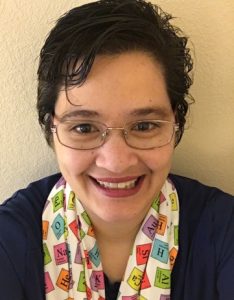
I’m Robin. I came to the wonderful world of academia as a non-traditional student and now I’m a non-traditional professor!
Educational Background:
The short version of the story is that I got my B.A. in chemistry from California State University, Los Angeles (in 1993) and my Ph.D. in chemistry from Colorado School of Mines (in 2015).
There’s a longer version of the story. Let’s just say that when I applied for grad school and people asked for records from all of the previous institutions I had attended, I had to send in five transcripts. I did many wonderful things between graduating with my BA and enrolling in grad school sixteen years later. Many of these were educational (though absolutely very few of them left a paper trail) and all have shaped the way I interact with students and scientific research.
How I developed my research interests:
Thanks to my unusual background, I also have a variety of research interests. My interest in contaminated soils was kindled when I started gardening at my first home which was located just 1/2 mile from a Superfund site. My interest in remediation stems from the disaster preparedness education I used to do in conjunction with the city of Sunnyvale, CA.
I love method development because I’m a “tool girl”–I love using power tools at home and I like finding the right tool for the job in scientific research, too.
I’m interested in research at the intersection of geology, biology, and chemistry because that’s what I did in graduate school. For my dissertation research I looked at factors affecting hydrogen peroxide kinetics in natural water systems, which meant measuring hydrogen peroxide production and decay in everything from local streams contaminated with agricultural runoff to the middle of the Pacific ocean. Although I did geochemical characterization of field sites, the most important factors seemed to be biological in nature; thus, I also spent time growing microbes (algae and bacteria) and looking at how they affected their environments, chemically speaking.
Finally, I’ve been interested in extraterrestrial life since I was five or so—that’s the age at which I decided I wanted to study astronomy when I grew up. When I was a teenager, my goal was to become an astronaut. When I was a young mom, I frequently dragged my kids to events at SETI headquarters in Mountain View. Needless to say, when I was offered the opportunity to help a friend on her astrobiology research, I jumped at it. I was originally brought on in the role of mineralogy consultant, but I also helped do a lot of the fieldwork. I still collaborate with my friend (Dr. Lynch, currently at Georgia Tech).
Put all these experiences together and you get a person with two main research foci–remediating contaminated sites and the potential for life on Europa, an ocean planet–and a strong interest in method development.

